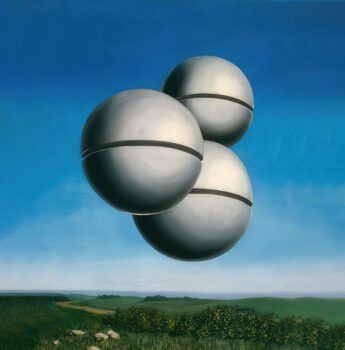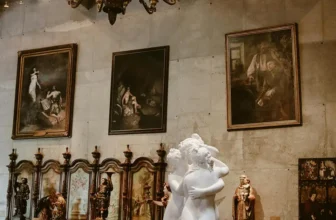Meaning of The Voice of Space by René Magritte
Among the many enigmatic works by the legendary Belgian surrealist René Magritte, The Voice of Space (La Voix des Airs) holds a special place. Painted in 1931, this haunting and dreamlike canvas features a number of floating bells suspended against a vast sky, evoking awe, curiosity, and a quiet disturbance that defines much of Magritte’s oeuvre. More than just an arrangement of surreal elements, The Voice of Space is a poetic meditation on perception, sound, silence, and the boundlessness of human thought.
In this article, we dive deep into the origins, analysis, symbolism, and legacy of this masterpiece. Who painted it, how and why it was painted, what it represents, and what it continues to whisper to us in the silence of space , all of this will be explored in detail.
Who Painted The Voice of Space and How It Was Created
The Voice of Space was painted by René Magritte, a pivotal figure in the surrealist movement. Born in 1898 in Lessines, Belgium, Magritte developed a visual language that relied on paradoxes, symbolic dislocation, and the juxtapositions of the familiar and unfamiliar. Rather than rely on abstraction or fantastical creatures, Magritte employed real-world objects , apples, bowler hats, curtains, clouds , and placed them in unorthodox or uncanny settings. This approach was deeply rooted in his philosophical inquiry about the nature of reality, language, and perception.
By 1931, when The Voice of Space was completed, Magritte had already begun to solidify his surrealist style. He painted this work during a particularly prolific period in Brussels after his return from Paris, where he had been associated with André Breton and the French Surrealists.
Magritte used oil on canvas for this piece, as he did for most of his major works. His technique was clean, precise, and intentionally traditional , often compared to advertising or academic painting , because he wanted the surreal elements to be rendered as convincingly as possible. By using realism as a tool, Magritte heightened the surrealism in the content itself. The process was methodical and slow; Magritte treated painting less like spontaneous emotional outpouring and more like quiet philosophical investigation.
What The Voice of Space Is All About
At first glance, The Voice of Space depicts a simple scene: three large metallic bells float against an expansive sky, hovering over a desolate landscape. There is no obvious narrative. There are no people, no visible source of sound, no action in the traditional sense. And yet, something about the image demands reflection. The stillness is deafening; the floating bells suggest something has been disrupted or unmoored from its usual context.
So what is The Voice of Space really about?
The painting explores themes of sound and silence, dislocation, symbolism, and the subconscious. The bells , typically associated with ringing, alarm, or announcement , are silent. There are no visible means by which they are suspended, and they seem disconnected from gravity or time. The title, The Voice of Space, implies an aural dimension that contradicts the complete visual silence of the canvas. This tension , between what is seen and what is heard, between the expected and the presented , lies at the heart of Magritte’s inquiry.
It’s not just a painting of bells in the sky. It’s a painting of expectation disrupted. We expect bells to ring, to hang from a belfry, to exist in a town square. Here, they drift in air like celestial bodies, silent and isolated, evoking the mystery of deep space and the subconscious.
Symbolism and Meaning in The Voice of Space
Magritte was never one to explain his paintings in clear terms. He once said:
“People who look for symbolic meanings fail to grasp the inherent poetry and mystery of the image.”
Yet, despite this resistance, the objects Magritte used were highly symbolic , not in a fixed or allegorical way, but in how they invoked layers of meaning. In The Voice of Space, several key symbols can be identified:
1. The Bells
Bells traditionally represent sound, celebration, warning, or divine communication. In religious and civic life, they mark time, gather people, and announce important events. In literature, bells have often symbolized death or transition , think of John Donne’s famous line, “for whom the bell tolls.”
Magritte renders the bells oversized and airborne. Their sound is muted. By divorcing them from their usual environment, he compels us to see them as objects of mystery rather than function. They might be symbols of communication lost or messages unheard. Alternatively, they may represent thoughts or memories drifting in the vast “space” of the mind.
2. The Sky
The sky in Magritte’s works is often a canvas of philosophical longing. It is the infinite, the unknown, the metaphor for freedom, mystery, and the unconscious. In this painting, the sky is mostly blue with a hint of clouds, suggesting daylight and clarity , but this clarity is contrasted by the irrational presence of the floating bells.
The sky can also be interpreted as a mental space, an inner world, where ideas float freely without logic or rules.
3. Levitation and Floating
The surreal act of objects floating is central to Magritte’s visual strategy. He often used levitation to suggest dislocation from reality. Floating bells suggest that gravity has lost meaning, and therefore so has reason or conventional truth. It’s a statement on how thoughts or perceptions might drift , untethered, poetic, and incomprehensible.
4. The Title: The Voice of Space
Titles were crucial in Magritte’s work and often added an extra layer of meaning or contradiction. “The Voice of Space” implies sound in a place of silence. Space, in astronomical terms, is a vacuum where no sound travels. In poetic terms, however, space might have a voice , the voice of imagination, memory, or dreams.
Thus, the title encourages us to listen rather than see, to feel rather than analyze. It suggests that some messages can only be received in silence or solitude , as though the bells are speaking without ringing.
What Is Happening in the Painting?
The Voice of Space is not a narrative painting. There is no visible action, and the viewer is not given a clear event to witness. But something is “happening” in a metaphysical sense.
The bells are in motionless flight. The scene appears frozen in time, like a still from a dream. The landscape below is distant and indistinct, suggesting a setting but offering no anchor. The only real “action” is the mental and emotional experience of the viewer , the recognition that this familiar object is now part of an unfamiliar world.
What’s “happening” is that the painting is activating a shift in perception. It invites the viewer to step out of literal interpretation and enter the logic of dreams, where sound can be seen, silence can speak, and meaning is elusive but resonant.
What Type of Art Is The Voice of Space?
The Voice of Space is a quintessential example of Surrealism , an art movement that emerged in the early 20th century as a response to rationalism, realism, and the horrors of World War I. Surrealists sought to tap into the unconscious mind, dreams, and irrational thought as sources of creativity and truth.
However, Magritte’s approach to Surrealism was different from contemporaries like Salvador Dalí or Max Ernst. He wasn’t interested in melting clocks or biomorphic forms. Instead, Magritte created a kind of “magic realism” , a world where objects appear normal but are placed in unusual contexts, thereby subverting their meaning.
In this sense, The Voice of Space is not just surreal , it is philosophical surrealism. It forces the viewer to confront the gap between appearance and meaning, and to recognize that logic is not always the key to truth.
Where Is The Voice of Space Located Today?
There are multiple versions of The Voice of Space created by Magritte , a common practice for the artist when he returned to themes or received commissions. The most famous version, and possibly the original 1931 version, is part of the Guggenheim Museum’s permanent collection in New York City.
This version is housed in the Solomon R. Guggenheim Museum, where it is celebrated as a cornerstone of the Surrealist holdings. The museum notes that this painting exemplifies Magritte’s ability to blend everyday objects with fantastical elements, capturing the essence of the subconscious.
Other variants or versions of the theme may be held in private collections or have been displayed in major exhibitions over the years.
Interpretation
Over the decades, The Voice of Space has inspired not only visual artists but also writers, musicians, and philosophers. Its haunting simplicity and profound ambiguity have made it a favorite among surrealist scholars and fans.
Critics have linked it to:
Freudian psychology, especially the symbolism of dreams and the unconscious.
Phenomenology, particularly the idea that our perceptions shape reality.
Modern poetry, for its juxtaposition of silent image and lyrical title.
The painting remains open-ended, which is perhaps its greatest strength. Every generation finds new meaning in it , whether as a metaphor for lost communication, the silence of modernity, the isolation of the self, or the vastness of human imagination.
What Does The Voice of Space Ultimately Represent?
Magritte’s The Voice of Space represents more than floating bells in an open sky. It is a meditation on sound and silence, presence and absence, perception and meaning. It challenges the viewer to see not just with the eyes, but with the mind and spirit. It invites introspection rather than explanation.
In the end, perhaps the painting’s voice is not a sound at all, but a feeling , a sensation of stillness, distance, and possibility. It is the voice of our own thoughts, drifting like bells across the infinite sky of our imaginations.
Quick Facts Summary:
Artist: René Magritte
Title: The Voice of Space (La Voix des Airs)
Year: 1931
Medium: Oil on canvas
Movement: Surrealism
Main Motif: Floating metallic bells in a sky
Themes: Sound, silence, perception, surrealism, the subconscious
Current Location: Solomon R. Guggenheim Museum, New York
Significance: A masterwork of surrealist imagery that questions the nature of reality and invites poetic contemplation.
If The Voice of Space could speak, it wouldn’t do so with words or sound. It would speak in silence , the kind that echoes in the corridors of the mind long after the eyes have looked away.




